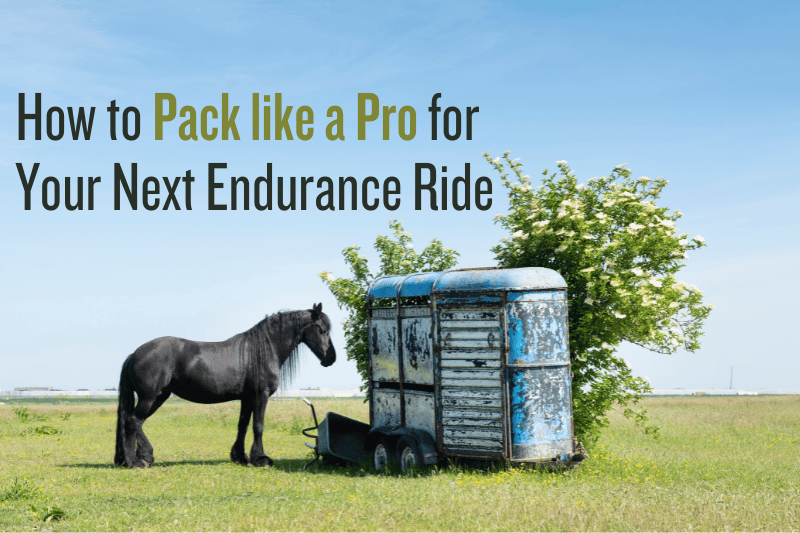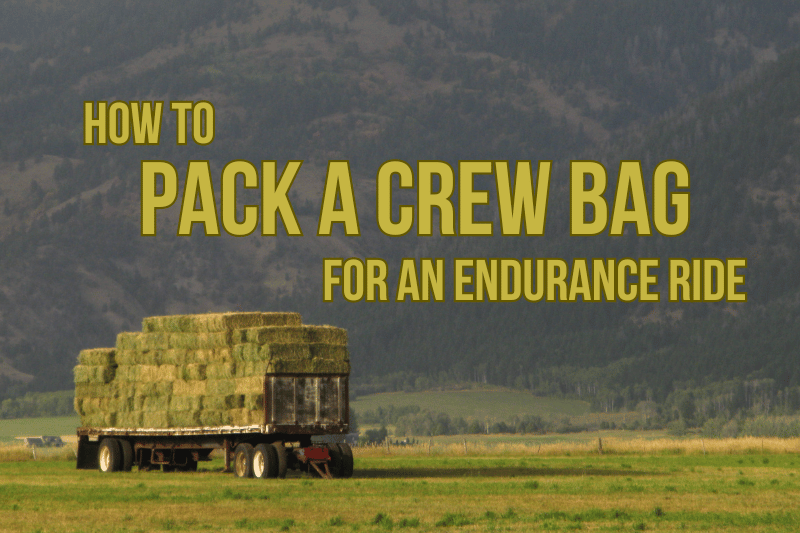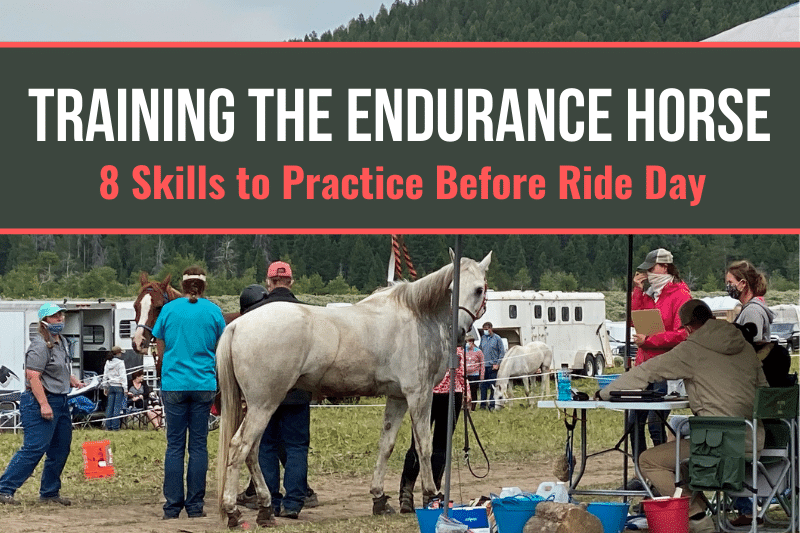Packing for an endurance ride can feel overwhelming. If you’ve ever stood between your trailer and a mountain of necessities, wondering how you’re going to stuff it all in there, you know how important it is to have a strategy for packing like a pro.
Last week, the good folks at the Old Dominion Equestrian Endurance Organization hosted a webinar during which several, experienced endurance riders shared their tips for packing for an endurance ride. The presenters included:
Teri Carroll: Endurance rider, ODEEO board member, and former professional organizer
Diane Connolly: Endurance rider, ride manager, and ODEEO board member
Lani Newcomb, DVM: Endurance vet, endurance rider and ODEEO board member
Dave Franklin: Endurance rider and ODEEO board member
Here are my notes, including a few new ideas that I’m going to try!
General Advice for Packing Like a Pro
Teri opened the webinar with some general advice drawn from her days as a professional organizer:
-
- Start with a plan.
-
- Clean out your space before starting to pack it.
-
- Reduce the sizes of items.
-
- Group like items together.
-
- Use containers that fit together.
-
- Use labels to make things easy to find.
-
- Do what works for you; there is no “right” way to pack.
Preparing Your Truck & Trailer
Dave offered practical advice on preparing and packing your truck and trailer, including:
-
- Have at least one spare trailer tire (with correct pressure). Having a second spare is ideal, in case you need to use the first with many miles to go.
-
- Consider buying a drive-on ramp to make trailer tire changes much easier.
-
- Pack your truck and trailer emergency tools and supplies near the door, where you can access them without unloading all your other stuff alongside the freeway.
-
- Make sure you have lug wrenches that will fit both your truck and trailer; they are probably different sizes.
-
- Create a pre-departure checklist including: vehicle fluids, tire pressure, lights, hitch lock, emergency chains, door/window pins, and LQ steps.
Packing an Equine Emergency Kit
Lani recommended keeping an emergency bag in easy reach while traveling with your horse:
-
- You may need to ease an ulcery stomach. Omeprazole take 3 days to have an effect. Sucralfate acts more quickly. Aloe may also be soothing.
-
- Lacerations of the head and legs are common in trailering situations, so have appropriate bandaging supplies handy.
-
- Hay in horses’ eyes is also common, so it’s smart to have eye ointment in your kit.
-
- If your vet has entrusted you with some prescription tranquilizers, bring them along in case your horse ends up waiting for a long time alongside the road. A bit of ACE could help him safely endure a stressful situation.
-
- Also bring bute or banamine, if provided by your vet.
-
- Every emergency bag should include a stethoscope, thermometer, and scissors.
Something that didn’t come up, but is always worth remembering: Be sure you’re familiar with AERC drug rules.
Want to assemble a comprehensive equine first aid kit? This post offers a printable list.
Preparing Your Horse Containment System
Teri and Lani discussed horse containment systems. They noted that each option (high-ties, electric fences, panels, etc.) comes with both positives and negatives. Here’s a post that links to even more posts on the various options.
- Different horses will do best with different systems.
- Remember that your containment system isn’t just there to keep your horse from running off; it can also protect him from other horses that may be running loose.
- Regardless of what you choose, be sure to practice at home! That way, both you and your horse will have a chance to fully understand the system. Lani recommended that electric fences, in particular, be tested within the confines of another fence for the horse’s safety.
- Some horses will put their heads through panels, even picking them up with their necks. Plastic mesh can be added to panels to prevent this behavior.
- Your containment system will be one of the first things you need upon arrival in ride camp, so it should be packed where it can be loaded first.
Packing Tack, Feed, & Horse Supplies
Diane and Lani shared some practical tips for packing horse supplies, including:
- Get buckets of the same brand so they all nest together to save space.
- Add hooks to your trailer, but if you put them in horse compartments, be sure they can be removed, collapsed, or covered when a horse needs to ride there. Pool noodles and duct tape can be used to make inexpensive hook covers.
- Hanging shoe organizers make good, cheap, grooming supply organizers.
- Consolidate to save space, rather than packing entire 50-pound bags of feed. You can use matching 5-gallon buckets with screw caps for different feeds.
- Supplements may be pre-measured into zip-top bags for easy feeding in camp.
- Remember that your horse will need more than his usual amount of feed during an endurance event.
- Plan ahead for vet check meals. Consider pre-bagging your horse’s usual meal, but also having other choices available in case he’s being picky.
- Camp is different from home, especially because your horse doesn’t have his usual shelter and ability to move around. Bring plenty of blankets and rain sheets to keep him warm.
- Horse blankets can be vacuum-packed with an inexpensive hand-pump bagging system to dramatically reduce bulk. The vacuum-packed blankets can be stored vertically (like file folders) in a tote for easy identification without digging through a stack.
- If you have multiple horses, organize each one’s tack all in one place.
Packing Your Saddle Bags
Lani and Teri offered some tips for packing saddle bags:
-
- Repurposed flip-lid condiment containers or kids’ sippy cups work well for pre-mixed electrolytes that need to ride with you on the trail.
-
- If your horse is shod, pack pliers in case you need to remove a loose shoe.
-
- Velcro cable ties can be used like zip-ties for emergency repairs; unlike zip-ties, they’re removable and reusable.
-
- To save space, pack small items inside your spare hoof boot(s).
-
- If you’ll be riding in the dark, a glow stick in your saddle bag can be used to read maps without blinding your companions.
-
- Be sure to clean out your saddle bags once in a while, as little-used items are likely to get rusty, sticky, moldy, or otherwise unusable over time.
For additional saddlebag packing tips, check out What to Pack in Your Saddle Bags for an Endurance Ride.
Preparing for a Great Crew Area
The presenters offered ideas for crew area essentials:
-
- Lani noted that while special-purpose crew bags are nice, you can get by without them. (Personally, I use large duffel bags from the thrift store. Blankets, feeds, etc. can be kept clean and organized in smaller bags within the duffel.)
-
- Dave recommended a collapsible, wheeled cart for hauling supplies from trailer to crew area.
-
- Teri suggested having a “rider box” that is separate from your horse supplies. Pack the box with items you think you’ll want, so you can easily access what you need and leave your crew free to tend to the horse. Have bags inside the box for each hold, and include to-do lists (fill water bottles, take Advil, etc.) so you are prepared when you head out on the next loop.
-
- A webinar attendee suggested having battery packs and charging cords handy during holds.
Packing for Rider Comfort
Diane, Teri, and Lani shared additional advice regarding rider supplies:
-
- Use the Velcro wrist straps on your gloves to attach them to your helmet strap so you don’t lose them.
-
- Have multiple pairs of shoes for riding, as well as muck boots to wear in dew or rain so your riding boots don’t get soaked before you even mount up.
-
- Pack for all kinds of weather, and plan to dress in layers. Mornings and evenings are likely to be colder than you expect. Make sure your crew also brings plenty of clothing options to keep themselves comfortable.
-
- Bring extra socks and change them during the hold.
-
- Consider keeping all your “night stuff” together so you don’t have to search for your headlamp, glow sticks, reflective vest, etc. as the sun goes down. You may also wish to keep your headlamp attached to your helmet all day if your riding a 100. Zip-ties work well for keeping it in place.
-
- Organize your clothes by day or purpose, and remember that you’ll probably be getting dressed in the dark on the day of the ride.
-
- Look for ways to make your living arrangements as comfortable as possible. Tables, chairs, outdoor rugs, and pop-up shelters make camp life easier.
-
- Frozen jugs of water can replace cooler ice, plus you can drink them as they thaw.
Preparing Your Packing List
Finally, Diane suggested updating your packing list each spring, printing it out, and laminating it. That way, you can check items off with a dry-erase marker and reuse the list all season.
Do you need a packing list? You can download mine for free!
You might also like
This post includes affiliate links, and I may earn a small commission (at no extra cost to you) when you purchase through these links. I only recommend products and services I think are helpful and useful. Thanks for helping me offset the cost of maintaining this blog as a free resource!



